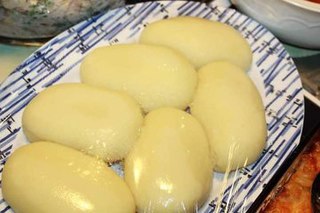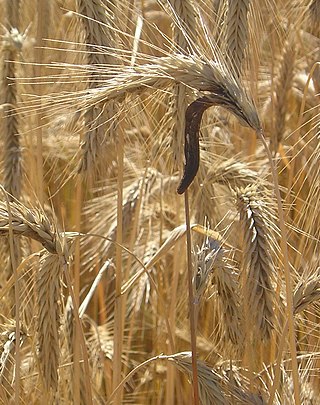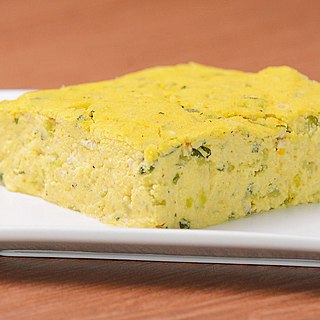Fungi is a plural form of fungus.
Fungi may also refer to:
- Fungi (music), a Caribbean music style
- Fúngi, a Central African food
- Cou-cou, also known as "fungi", a Caribbean food
Fungi is a plural form of fungus.
Fungi may also refer to:

A mushroom or toadstool is the fleshy, spore-bearing fruiting body of a fungus, typically produced above ground, on soil, or on its food source. Toadstool generally denotes one poisonous to humans.

A mold or mould is one of the structures that certain fungi can form. The dust-like, colored appearance of molds is due to the formation of spores containing fungal secondary metabolites. The spores are the dispersal units of the fungi. Not all fungi form molds. Some fungi form mushrooms; others grow as single cells and are called microfungi.

Edible mushrooms are the fleshy fruit bodies of several species of macrofungi. Edibility may be defined by criteria including the absence of poisonous effects on humans and desirable taste and aroma. Edible mushrooms are consumed for their nutritional and culinary value. Mushrooms, especially dried shiitake, are sources of umami flavor.

Fufu is a pounded meal found in West African cuisine. It is a Twi word that originates from the Akans in Ghana. The word has been expanded to include several variations of the pounded meal found in other African countries including Sierra Leone, Guinea, Liberia, Cote D'Ivoire, Burkina Faso, Benin, Togo, Nigeria, Cameroon, the Democratic Republic of Congo, the Central African Republic, the Republic of Congo, Angola and Gabon.
AMF may refer to:
Elf Cup may refer to:

Wood-ear or tree ear, also translated wood jellyfish or tree jellyfish, can refer to a few similar-looking edible fungi used primarily in Chinese cuisine; these are commonly sold in Asian markets shredded and dried.

A sclerotium, is a compact mass of hardened fungal mycelium containing food reserves. One role of sclerotia is to survive environmental extremes. In some higher fungi such as ergot, sclerotia become detached and remain dormant until favorable growth conditions return. Sclerotia initially were mistaken for individual organisms and described as separate species until Louis René Tulasne proved in 1853 that sclerotia are only a stage in the life cycle of some fungi. Further investigation showed that this stage appears in many fungi belonging to many diverse groups. Sclerotia are important in the understanding of the life cycle and reproduction of fungi, as a food source, as medicine, and in agricultural blight management.

Barbadians or Bajans (pronounced BAY-jənz) are people who are identified with the country of Barbados, by being citizens or their descendants in the Barbadian diaspora. The connection may be residential, legal, historical or cultural. For most Barbadians, several of those connections exist and are collectively the source of their identity. Barbadians are a multi-ethnic and multicultural society of various ethnic, religious and national origins; therefore Barbadians do not necessarily equate their ethnicity with their Barbadian nationality.

Cou-cou, coo-coo, or fungie makes up part of the national dishes of Antigua and Barbuda, Barbados, British Virgin Islands and the U.S. Virgin Islands. It consists mainly of cornmeal and okra (ochroes). Cornmeal, which comes readily packaged and is available at supermarkets islandwide, and okra, which can be found at supermarkets, vegetable markets and home gardens, are very inexpensive ingredients. Because these main components are inexpensive, the dish became common for many residents in Barbados' early colonial history. In Ghana, a similar meal of fermented corn or maize flour eaten with okra stew and fish is known as banku, a favourite dish of the Ga tribe in Accra.
Diadema is the term for diadem in most Romance languages, and in English may refer to:

Fungivory or mycophagy is the process of organisms consuming fungi. Many different organisms have been recorded to gain their energy from consuming fungi, including birds, mammals, insects, plants, amoebas, gastropods, nematodes, bacteria and other fungi. Some of these, which only eat fungi, are called fungivores whereas others eat fungi as only part of their diet, being omnivores.

A fungus is any member of the group of eukaryotic organisms that includes microorganisms such as yeasts and molds, as well as the more familiar mushrooms. These organisms are classified as one of the traditional eukaryotic kingdoms, along with Animalia, Plantae and either Protista or Protozoa and Chromista.

Mycoforestry is an ecological forest management system implemented to enhance forest ecosystems and plant communities through the introduction of mycorrhizal and saprotrophic fungi. Mycoforestry is considered a type of permaculture and can be implemented as a beneficial component of an agroforestry system. Mycoforestry can enhance the yields of tree crops and produce edible mushrooms, an economically valuable product. By integrating plant-fungal associations into a forestry management system, native forests can be preserved, wood waste can be recycled back into the ecosystem, carbon sequestration can be increased, planted restoration sites are enhanced, and the sustainability of forest ecosystems are improved. Mycoforestry is an alternative to the practice of clearcutting, which removes dead wood from forests, thereby diminishing nutrient availability and reducing soil depth.
A calyptra is a feature of plant formation. Calyptra may also refer to:

Food spoilage is the process where a food product becomes unsuitable to ingest by the consumer. The cause of such a process is due to many outside factors as a side-effect of the type of product it is, as well as how the product is packaged and stored. Due to food spoilage, one-third of the world's food produced for the consumption of humans is lost every year. Bacteria and various fungi are the cause of spoilage and can create serious consequences for the consumers, but there are preventive measures that can be taken.
Plagiostoma is the genus name for two groups of organisms and may refer to:
Pixie cup may refer to:

Funge or fúngi (Angola) or mfundi is a traditional African swallow made of cassava flour whisked into boiling water. It can also be made with sorghum, maize, or millet. It can be served with textured vegetable, fish, or meat stew, as well as other vegetable, meat, and fish dishes. Funge is a staple food in African cuisine. Some richer and more flavorful versions may be made with stock, like fish stock, instead of water. It is also known as bidia.

Fungi are a common theme or working material in art. They appear in many different artworks around the world, starting as early as around 8000 BCE. Fungi appear in nearly all art forms, including literature, paintings, and graphic arts; and more recently, contemporary art, music, photography, comic books, sculptures, video games, dance, cuisine, architecture, fashion, and design. There are a few exhibitions dedicated to fungi, and even an entire museum.